How to Introduce a Baby to a Blind Dog

Erotikon, 2005–2009
Erotikon I
2005
Letterpress on Crane's Fluorescent White 179 lb. Cover, 13.5 x 11
Edition of 30
Printed by Mark Fox with the assistance of Richard Seibert at St. Hieronymous Press, Berkeley
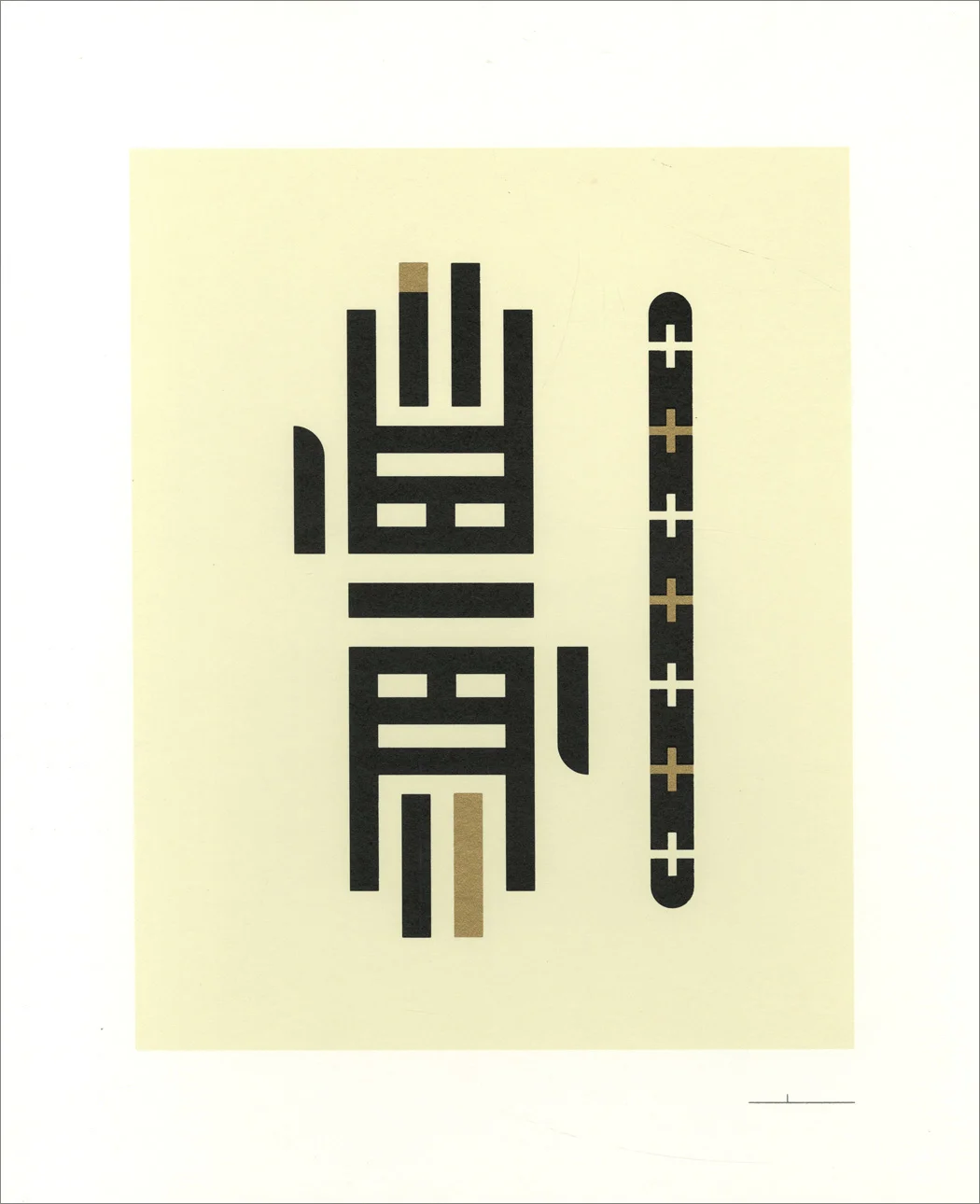
Erotikon, 2005–2009
Erotikon II
2008
Screen print, 11 x 13.5
Printed by Mick Amaral at Acme Screen Printing

Erotikon, 2005–2009
Erotikon III
2009
Screen print on Arches black rag, 11 x 13.5
Printed by Kevin Giffen at Wranch Studios

Erotikon, 2005–2009
Erotikon IV
2009
Offset lithography with blind embossing on Crane's Fluorescent White 134 lb. Cover, 13.5 x 11
Printed by Digital Engraving, San Francisco

Erotikon, 2005–2009
Erotikon V
2009
Screen print on chipboard, 13.5 x 11
Printed by Kevin Giffen at Wranch Studios

Erotikon, 2005–2009
Erotikon VI
2009
Screen print on two-ply museum board, 13.5 x 11
Printed by Kevin Giffen at Wranch Studios

Erotikon, 2005–2009
Erotikon VII
2009
Letterpress on French Dur-O-Tone Butcher Orange 80 lb. Cover, 13.5 x 11
Printed by Digital Engraving, San Francisco

Erotikon, 2005–2009
Erotikon VIII
2009
Test print, 11 x 13.5

Erotikon, 2005–2009
Erotikon IX
2009
Test print, 11 x 13.5

Assemblage Paintings
Spine (for Clay)
1994
Gesso on wood; wrench; collage; photography. 14.5 x 8
This series of paintings was exhibited as part of a group show that included work by Greg Clarke and Gary Baseman. "Wisegeist Too" opened at the Clay Doyle Gallery in West Hollywood in November, 1994.
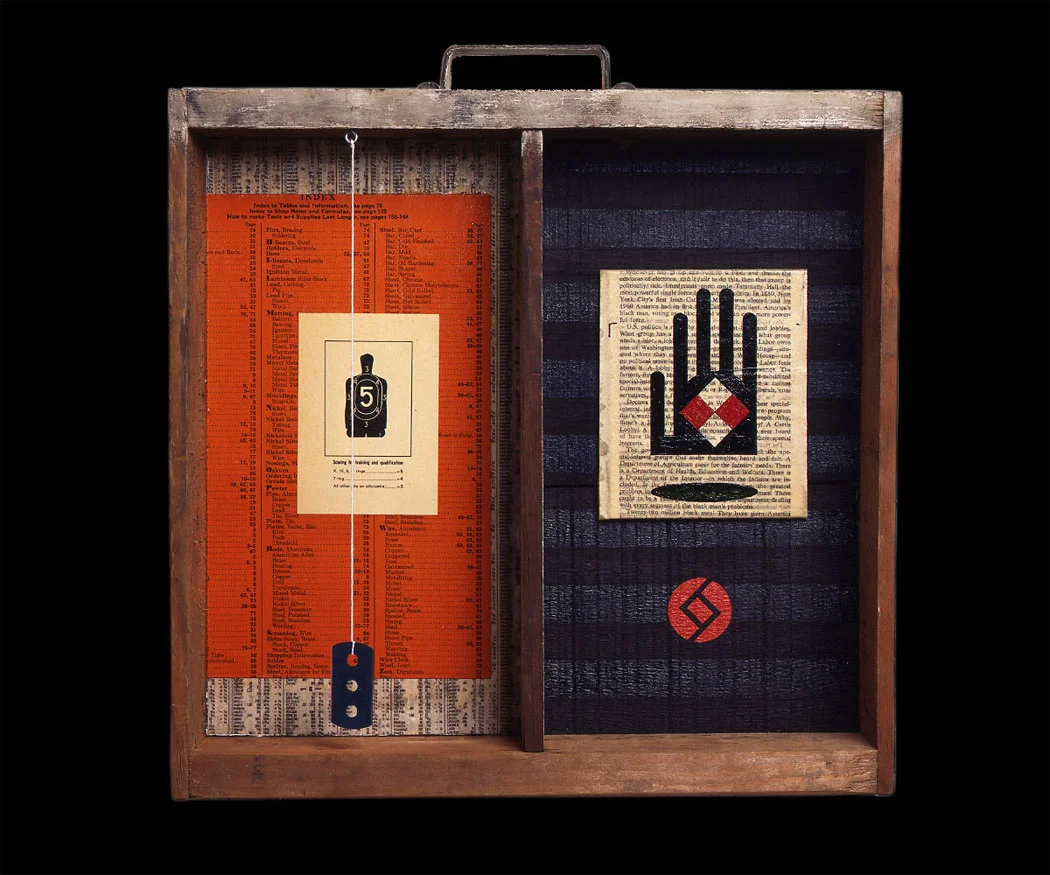
Assemblage Paintings
Portable Ritual
1994
Oil on wood; razor blade; collage. 14 x 13.5

Assemblage Paintings
Fervor (with Greg Clarke)
1994
Left panel: Alkyd on wood (Greg Clarke). Right panel: Oil on wood; fishing lure; photography (Mark Fox). 14 x 13.5
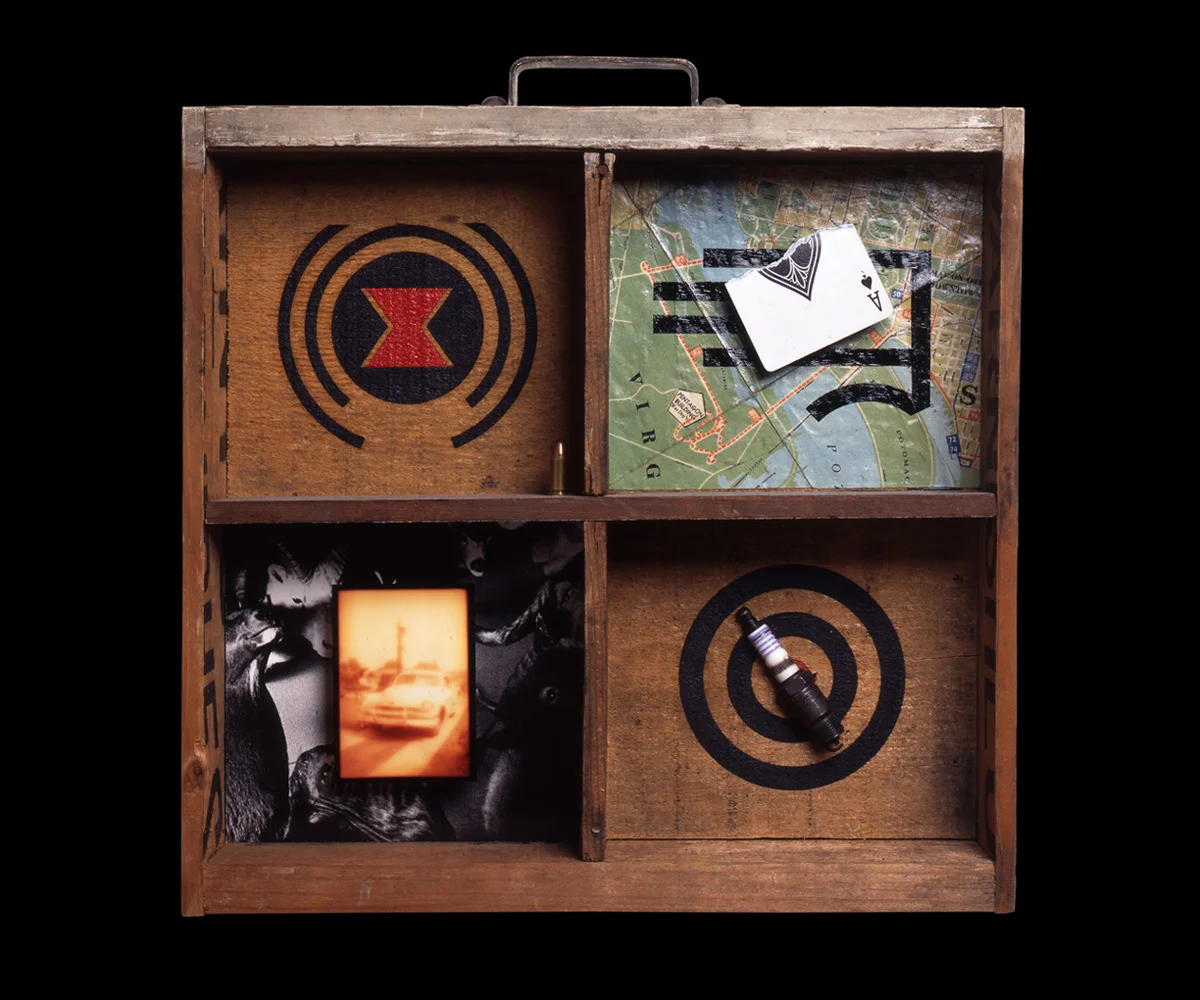
Assemblage Paintings
Presidential Library
1994
Oil on wood; bullet; spark plug; photography; collage. 14 x 13.5
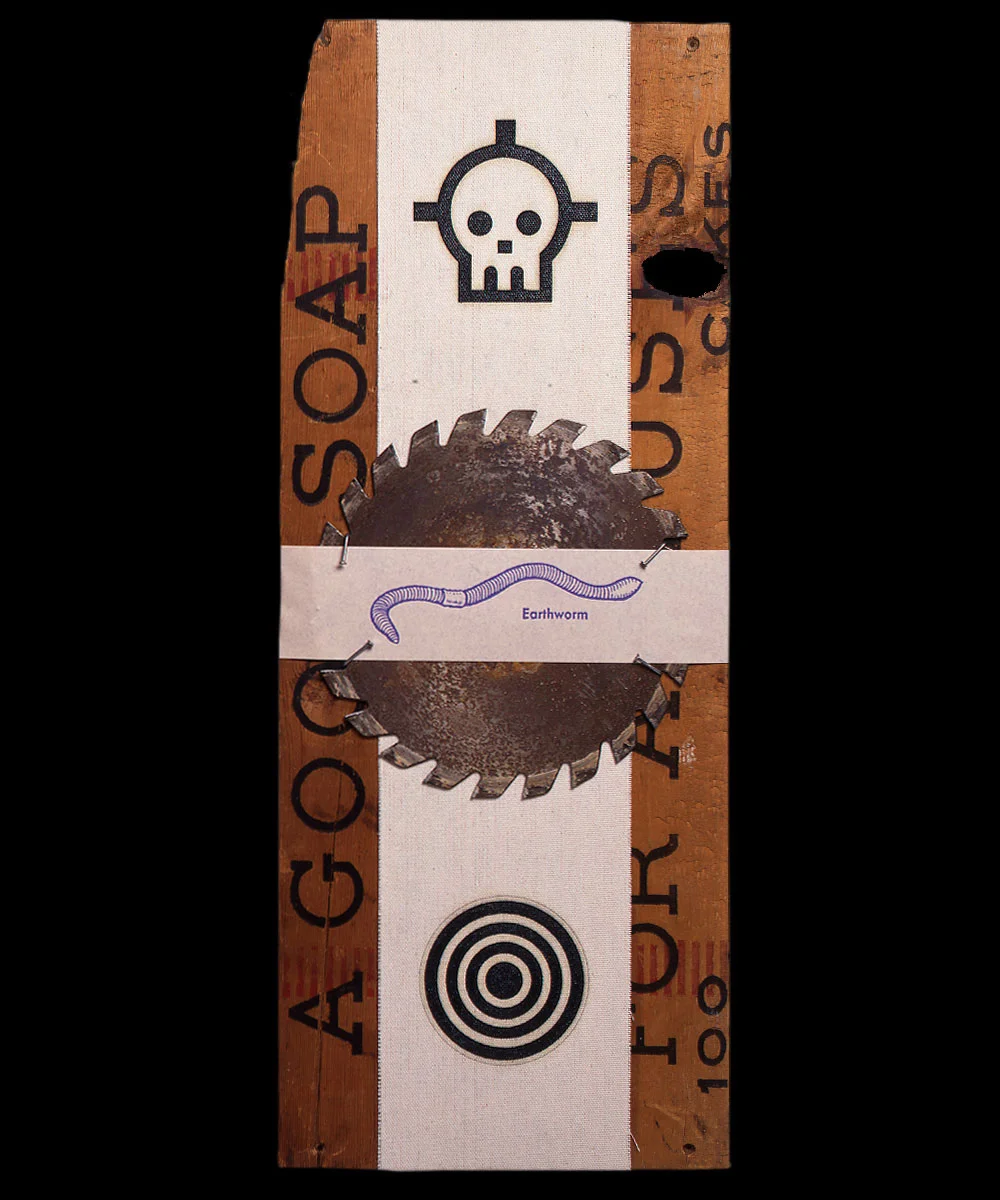
Assemblage Paintings
Bone
1994
Oil on raw canvas on wood; rotary saw blade; blueprint. 8 x 20.25
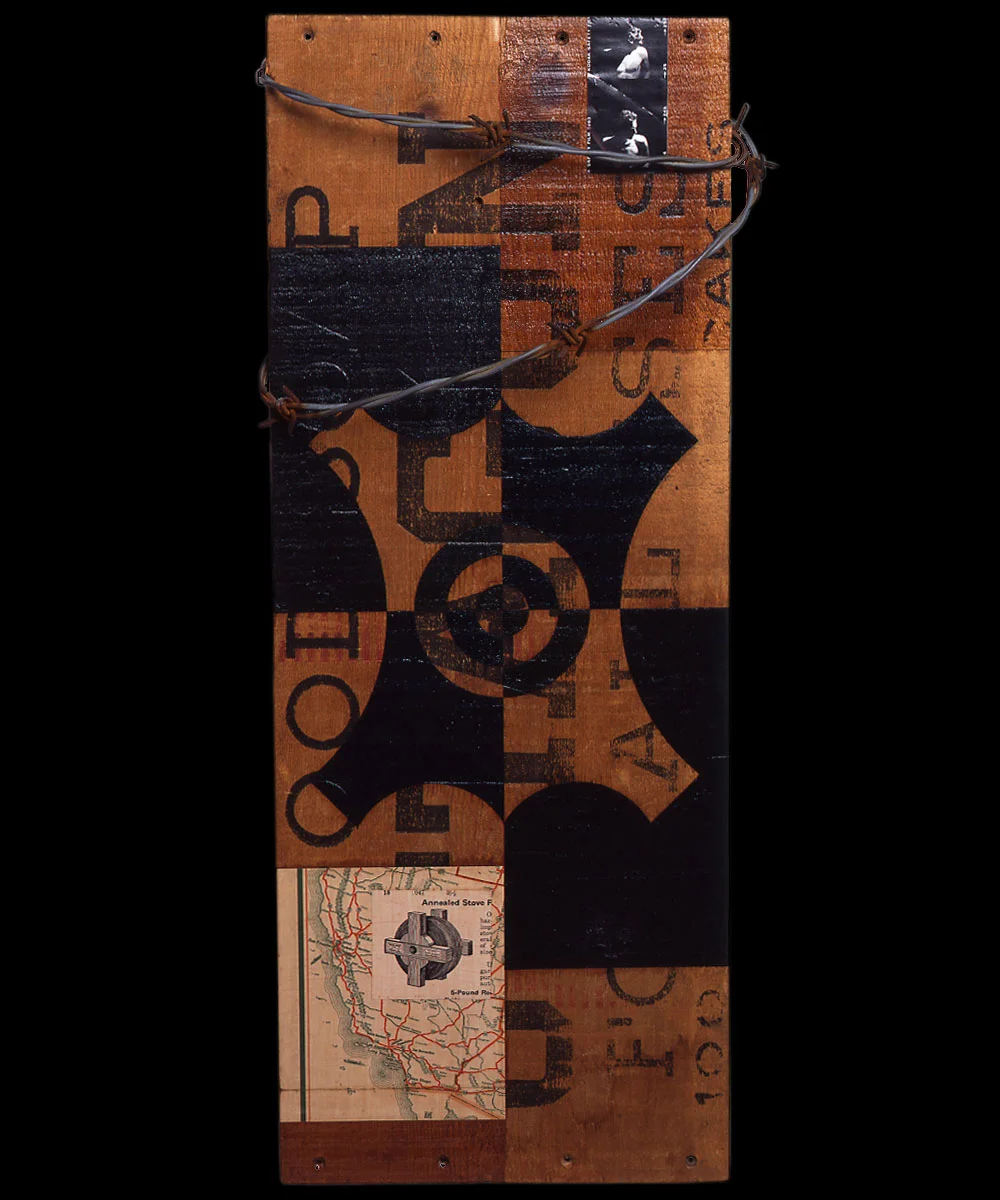
Assemblage Paintings
Curfew
1994
Oil on wood; barbed wire; photography; collage. 8 x 20.25

1993 Beaux Arts Ball
Centerpiece
1993
Painted steel; vise; block glass vase; calla lilies.
Screen printing and fabrication of all metalwork by Wasserman Silk Screen Co.
I participated in the 1993 Beaux Arts Ball, an annual museum benefit, which was organized by the San Francisco Museum of Modern. Forty local designers and architects were invited to create table settings for the event's guests, including centerpieces, place settings, and masks.
Inspired by the anti-art themes found in Constructivist writings and manifestos, my work won first prize. Judge Michael Manwaring described it as "A sharp, clean blast in a roomful of frippery."
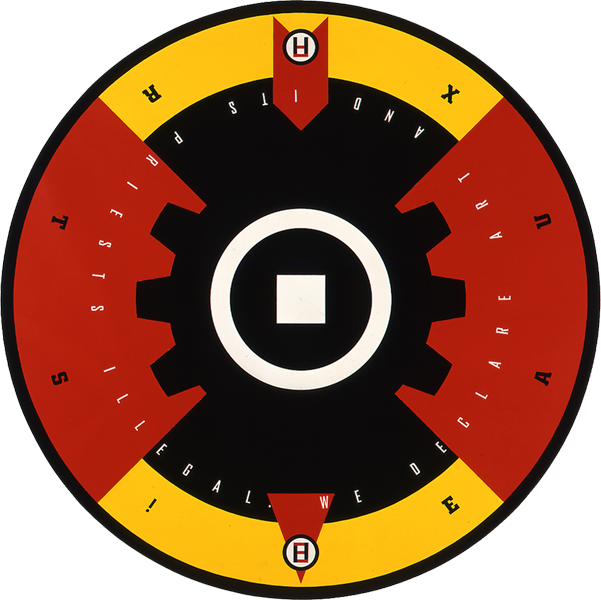
1993 Beaux Arts Ball
Tablecloth
1993
The hand-painted tablecloth reads, "We declare art and its priests illegal." Text by Medunetskii, Stenberg, and Stenberg, 1922.

1993 Beaux Arts Ball
Table Setting
1993
The table setting uses bicycle sprockets as napkin rings and common tools as utensils. The service plate reads, "In the final analysis, art is falsehood, an opiate, and unnecessary. Work for life, and not for palaces, churches, graveyards, and museums." Texts by Ioganson, 1922; and Rodchenko, 1921.

1993 Beaux Arts Ball
Mask
1993
The mask reads, "Death to art! Efficacious existence is the highest beauty." Texts by Gan, 1922; and Gabo and Pevsner, 1920.

Agitprop, 1990–2014
Kinder, Gentler, Carpet Bombing
1990 (Pre-U.S. invasion of Iraq)
Xerox, 11.25 x 10.125
Collections: United States Library of Congress, Prints and Photographs Division; AIGA Design Archives at the Denver Art Museum; Stedelijk Museum Amsterdam
Using an amended quote from George H.W. Bush's nomination acceptance speech in 1988, this poster predates the first American invasion of Iraq in 1991.
The "GTO" designation in the lower right-hand corner is an abbreviation for Graphic Terrorist Organization, a name suggested by Seattle designer Art Chantry.
This poster is included in the 2013–2015 exhibition "Drawn to Action: Posters from the AIGA Design Archives" at the Denver Art Museum.

Agitprop, 1990–2014
End Pollution: Bomb the Pentagon
1991 (Post-U.S./Iraq War)
Screen print on corrugated cardboard, 24 x 36
Printed at Wasserman Silk Screen and Acme Screen Printing
Collections: Los Angeles County Museum of Art (LACMA); AIGA Design Archives at the Denver Art Museum; Stedelijk Museum Amsterdam
The pollution in the title is both literal and moral. What degradations to our environment—or our democratic values—are acceptable in the interest of national security?
You can read more about this poster on my blog.

Agitprop, 1990–2014
Cover Your Head
1992
Screen print on archival rag, 26 x 31
Printed by Wasserman Silk Screen Co.
Collections: San Francisco Museum of Modern Art (SFMOMA); Los Angeles County Museum of Art (LACMA); AIGA Design Archives at the Denver Art Museum; Stedelijk Museum Amsterdam
I originally designed this safe-sex poster for ACTUP!NY but the design was rejected.

Agitprop, 1990–2014
Elvis Ain't King
1992
Screen print on rag paper, 39 x 19.25
Printed by Wasserman Silk Screen Co.
Collections: United States Library of Congress, Prints and Photographs Division; San Francisco Museum of Modern Art (SFMOMA); Los Angeles County Museum of Art (LACMA); Stedelijk Museum Amsterdam
A response to the 1991 Rodney King beating and subsequent acquittal of the four L.A.P.D. officers responsible. The title is a reference to both Rodney and Martin Luther King, as well as to the Public Enemy lyric from "Fight the Power:" "Elvis was a hero to most / But he never meant shit to me." The glyph on the left half of the poster signifies division.

Agitprop, 1990–2014
Tricky Ollie
1998 (second version)
Screen print on chipboard, 19 x 28.25
Printed by Mick Amaral at Acme Screen Printing
Collections: Los Angeles County Museum of Art (LACMA); Stedelijk Museum Amsterdam. (The original, 1994 xerox version of this design is in the AIGA Design Archives at the Denver Art Museum.)
Designed to oppose Oliver North's U.S. Senate bid in 1994, this poster fuses North with an earlier Republican who considered himself above the law, Richard Nixon. (Nixon was famously known as "Tricky Dick.")
This poster is included in the 2013–2015 exhibition "Drawn to Action: Posters from the AIGA Design Archives" at the Denver Art Museum.

Agitprop, 1990–2014
Shredded Ollie
1998 (second version)
Letterpress, 22.75 x 14.875
Printed by Hatch Show Print
Collection: The original, 1994 xerox version of this design is in the AIGA Design Archives at the Denver Art Museum
North is infamous for, among other ethical lapses, shredding documents sought by Congress during their investigation into the Iran-Contra scandal.

Agitprop, 1990–2014
Republican Contract on America
1995
Screen print on chipboard, 24 x 24
Printed by Mick Amaral at Acme Screen Printing
Collections: San Francisco Museum of Modern Art (SFMOMA); Los Angeles County Museum of Art (LACMA); AIGA Design Archives at the Denver Art Museum; Stedelijk Museum Amsterdam
A quote by Nazi Hermann Göring is used to highlight the anti-intellectual, anti-cultural stance of the Republican-controlled 104th U.S. Congress.
Ralph Reed (formerly of the Christian Coalition) controls the chamber; Newt Gingrich is the hammer; Bob Packwood—at the time under investigation for sexual misconduct—is the grip; Jesse Helms is the trigger. There is no sight.

Agitprop, 1990–2014
Enigma
1997
Screen print on Simpson Starwhite Vicksburg, 24 x 36
Printed by Mick Amaral at Acme Screen Printing
Collection: San Francisco Museum of Modern Art (SFMOMA)
I was invited to design a poster for an AIGA Colorado event with the theme of literacy. The design uses a map with all of the place-names crossed out as a metaphor for illiteracy, the idea being that one is lost without the ability to read.
The word ENIGMA—constructed from both letters and numerals—is an allusion to the mystery of language and our symbol system that attempts to codify it.

Agitprop, 1990–2014
howiloveya
1998
Screen print on various newspapers, approximately 23 x 13.625
Printed by Mick Amaral at Acme Screen Printing
Collection: San Francisco Museum of Modern Art (SFMOMA)
Mickey Mouse made his screen debut in 1928, one year after Al Jolson's talkie "The Jazz Singer" was released. The similarities between Mickey and white blackface performers such as Jolson are striking.

Agitprop, 1990–2014
The Great Seal (after El Lissitsky)
1998
Screen print on Simpson Starwhite Vicksburg, 20 x 25.5
Printed by Kevin Giffen at Wranch Studios
Collections: San Francisco Museum of Modern Art (SFMOMA); Los Angeles County Museum of Art (LACMA); Stedelijk Museum Amsterdam
A mélange of imperial symbols: the bald eagle from the U.S. one dollar bill with the Czarist double-headed eagle, decapitated by El Lissitsky in 1923.

Agitprop, 1990–2014
The Great Sale
1998
Screen print on kraft shopping bag, 16 x 19
Printed by Kevin Giffen at Wranch Studios
Collection: San Francisco Museum of Modern Art (SFMOMA)
The Great Seal goes shopping.

Agitprop, 1990–2014
Names of the Dead (Vote)
2004
Digital print, 53.875 x 48.75
I was one of six local designers asked to create a poster for an AIGA San Francisco project aimed at increasing voter turnout in November, 2004. Posters in this series were placed in JCDecaux advertising kiosks along Market Street in downtown San Francisco.
The concept is simple: the word VOTE must be read through a soldier's obituary as listed in the newspaper.

Agitprop, 1990–2014
Patriotism
2002
Screen print on dollar bill, approximately 6.125 x 2.625
Printed by Mick Amaral at Acme Screen Printing
Collection: Stedelijk Museum Amsterdam
A response to George W. Bush's suggestion that patriotic Americans go shopping after 9/11.

Agitprop, 1990–2014
War For Sale
2002
Epson print, 10 x 14
Displayed in my car, this auto placard notes George W. Bush's efforts to sell the Iraq war to Americans. "From a marketing point of view," said Andrew H. Card Jr., White House chief of staff, "you don't introduce new products in August." The Bush administration launched the war six months later.

Agitprop, 1990–2014
1958 (Peace)
2014
Offset lithography, 10 x 10
To celebrate the American Institute of Graphic Arts' centennial, the AIGA asked 100 designers to create "a piece of artwork that makes a social, political or cultural statement about one year from AIGA's history."
I chose the year 1958 so I could work with Gerald Holtom's timeless symbol for Nuclear Disarmament—what would eventually become known as the "Peace Sign." As this mark has long been appropriated for commercial purposes—one can buy Baby Gap clothes emblazoned with the symbol—it has lost its primary meaning and urgency as a sign. My intention was to remind folks of the symbol's original meaning and hopefully reintroduce to it qualities of urgency and even threat.

1999 SFMOMA Exhibit
Opening
1999
Offset lithography, 4.5 x 6.25
Printed by Digital Engraving
Collection: San Francisco Museum of Modern Art (SFMOMA)
This is the front panel of my cheeky invitation to the SFMOMA exhibit, "BlackDogma: Selections from the Work of Mark Fox in the Permanent Collection of Architecture + Design." The show was organized and curated by Aaron Betsky, and ran from April to June, 1999.

1999 SFMOMA Exhibit
View of the gallery with Eikon (right) and Beware of God (left).

1999 SFMOMA Exhibit
Capitalism Consuming His Children (Moloch)
1997
Iris print on archival rag, 24 x 34
Printed by Urban Digital Color
Collection: San Francisco Museum of Modern Art (SFMOMA)
I designed this piece for an environmental poster exhibit in Kyoto, Japan. The theme of the exhibit was "the Earth," and it was held in conjunction with the United Nations Framework Convention on Climate Change. (This is the conference which issued the Kyoto Protocol, the world's first climate change treaty.) 100 "distinguished artists" from around the world were invited to participate; representing the United States were Ivan Chermayeff, Seymour Chwast, Gene Frederico, Massimo Vignelli, and myself.
The image is inspired by Francisco Goya's 1819–23 painting Saturn Devouring His Children. Moloch is an ancient Semitic god whose worship involved human sacrifice, specifically the burning of children.

1999 SFMOMA Exhibit
View of the gallery with Cover Your Head (right).

1999 SFMOMA Exhibit
The following text accompanied the exhibit:
Mark Fox is San Francisco's leading proponent of agitprop. This form of "agitation propaganda" was developed by Russian graphic designers to further the cause of the Bolshevik Revolution after 1917. Fox adopts their technique of distilling designs into direct, condensed formal symbols in order to make arguments about sexuality, politics, and cultural freedom. He also introduces a poetic sense of enigma into his work. In an age in which we no longer believe in simple solutions, whether they are graphic or political, Fox hints at a higher power of persuasion that comes from implying a great deal without offering any pat answers.
A master at the specialized task of designing logos and symbols, Fox is, in all of his work, a graphic designer who both clarifies and complicates. With a simple image, form, or typeface, he sums up the nature of a corporation, brand, or institution. He has done so for a broad range of companies such as Apple Computer, Nike, Oracle, and the Buckeye Roadhouse, as well as for SFMOMA's Architecture + Design Forum. Fox's icons often bring to mind the legends or symbols of ancient or lost cultures, now streamlined for consumer use. His designs have the impact of early twentieth-century propaganda, the aura of medieval myth, and the thought-provoking quality of a work of critical art.
When not designing for clients, Fox produces posters and paintings that call into question general assumptions about simple images. Working primarily with silkscreen prints, Fox creates politically charged and evocative designs that seem to jump off the wall. For example, he printed the outlines of Mickey Mouse and Al Jolson onto the stock pages of The New York Times and other newspapers, titling the work howiloveya. In another piece, he juxtaposes a grainy photograph of Rodney King being beaten with the title Elvis Ain't King. For a work called The Great Sale, he printed a shopping bag with the old Russian empire shield superimposed over the Great Seal found on the United States one dollar bill. In this image, Fox used a version of the Russian shield created by the Russian Constructivist El Lissitsky, in which the double-headed eagle has been decapitated. In an even more enigmatic piece entitled Body Politic, Fox created a silk screen by enlarging images of the bodies of ants to the point where they became abstract forms or typography. Fox also transformed one of the ant motifs into a single red icon that he titled Flag. It is these images that make up this selection from SFMOMA's permanent collection of architecture and design. They reveal the mind of a mature and powerful designer who makes us unsure about the meaning of his marks.
Fox graduated from the University of California, Los Angeles, with a Bachelor of Fine Arts degree in 1984. He opened his own design studio, BlackDog, in 1986, and he currently lives and works in Marin County. Fox is a past president of the San Francisco Chapter of the American Institute of Graphic Arts (AIGA) and teaches at the California College of Arts and Crafts.
Aaron Betsky
Curator of Architecture, Design + Digital Projects
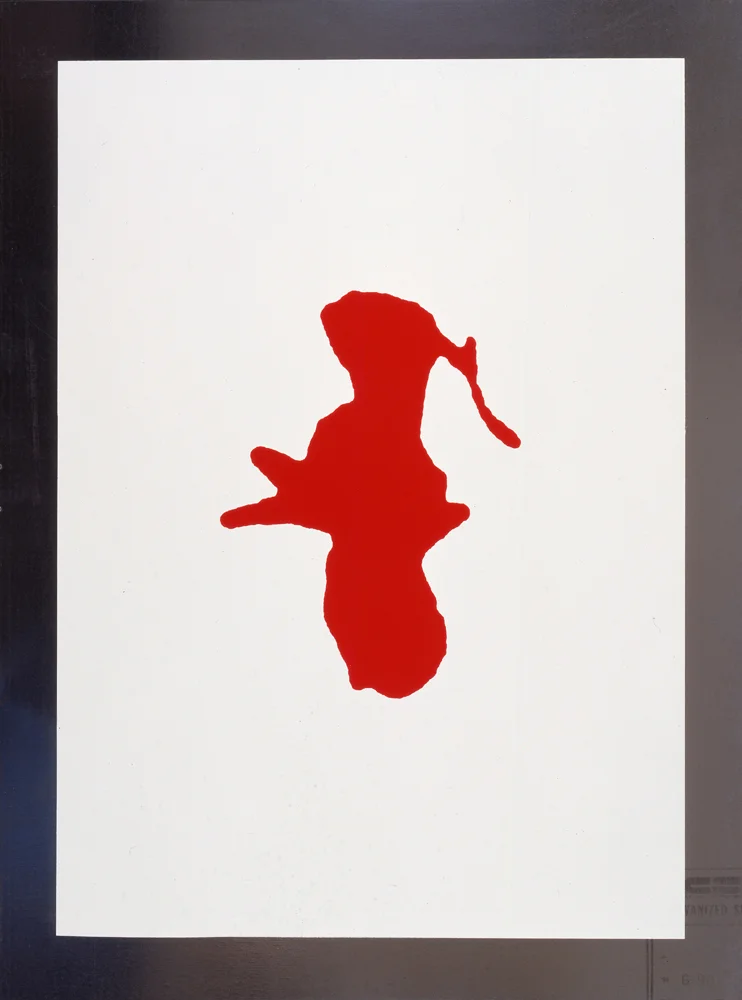
1999 SFMOMA Exhibit
Flag
1998
Screen print on sheet metal, 24 x 32
Printed by Mick Amaral at Acme Screen Printing
Collection: San Francisco Museum of Modern Art (SFMOMA)
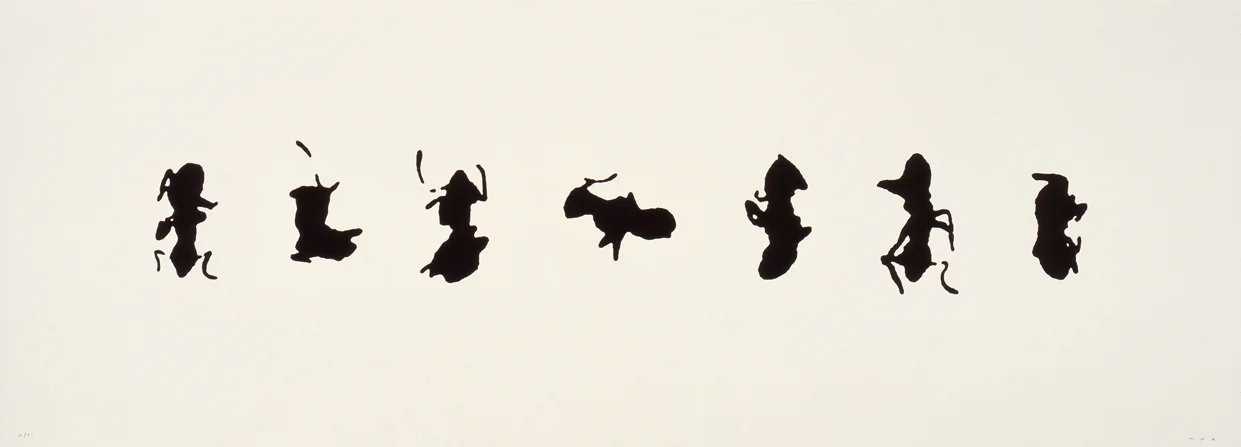
1999 SFMOMA Exhibit
Body Politic
1998
Screen print on archival board, 53.75 x 19.5
Printed by Kevin Giffen at Wranch Studios
Collection: San Francisco Museum of Modern Art (SFMOMA)

Photography, 1983–1984
Untitled
1983
Most of the following color photographs were part of a series of twenty-eight images I created as a junior at UCLA. They were flush-mounted in a single frame—I wanted them to function like a sequence of jump cuts in a film. The piece was created for Mark McFadden's photography class.

Photography, 1983–1984
Untitled
1983

Photography, 1983–1984
Untitled
1983

Photography, 1983–1984
Untitled
1983

Photography, 1983–1984
Untitled
1983

Photography, 1983–1984
Untitled
1983

Photography, 1983–1984
Untitled
1983

Photography, 1983–1984
Untitled
1983

Photography, 1983–1984
Untitled
1983

Photography, 1983–1984
Untitled
1983

Photography, 1983–1984
Untitled
1983
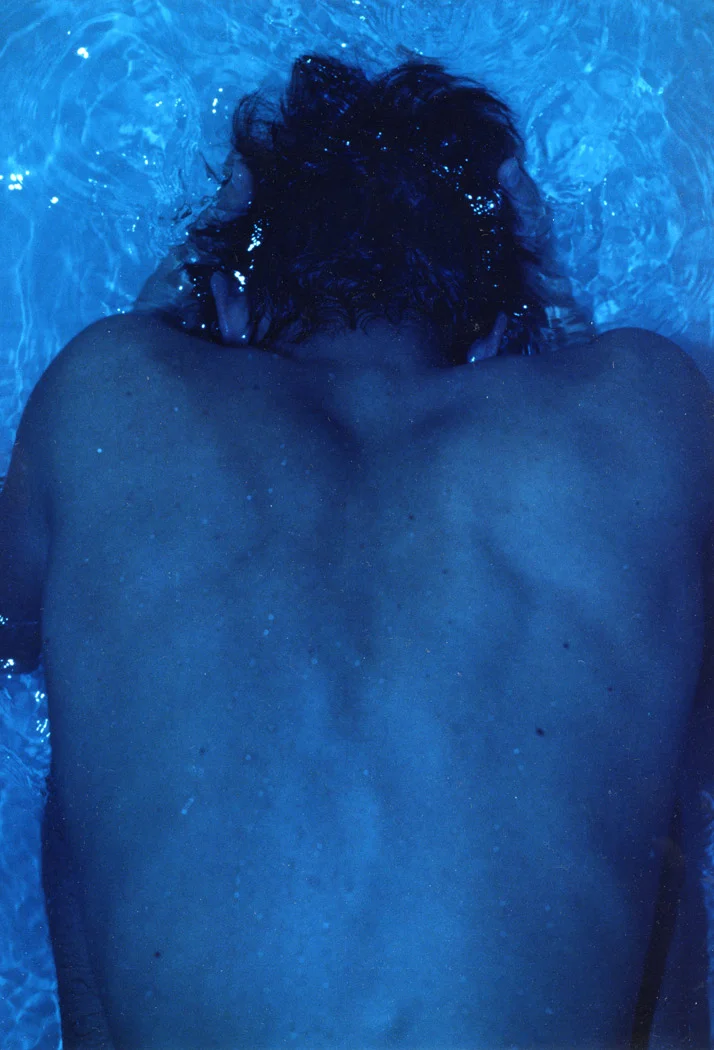
Photography, 1983–1984
Untitled
1983

Photography, 1983–1984
Untitled (Emily)
1983

Photography, 1983–1984
Untitled
1984
Most of the following black and white photographs formed part of a series of diptychs I produced as a senior at UCLA. The series is named "Stray Dog Running: Wanderings Through Nod," and it was created for Robert Heinecken's photography class.

Photography, 1983–1984
Untitled
1984

Photography, 1983–1984
Untitled
1984

Photography, 1983–1984
Untitled
1984

Photography, 1983–1984
Untitled
1984

Photography, 1983–1984
Untitled
1984

Photography, 1983–1984
Untitled
1984

Photography, 1983–1984
Untitled
1984
Hand-tinted photograph, 16 x 20
How to Introduce a Baby to a Blind Dog
Source: http://www.blackdog.com/
Belum ada Komentar untuk "How to Introduce a Baby to a Blind Dog"
Posting Komentar